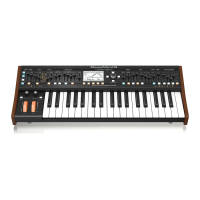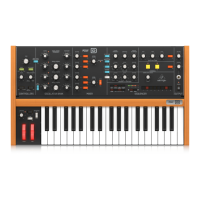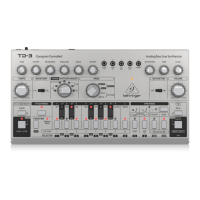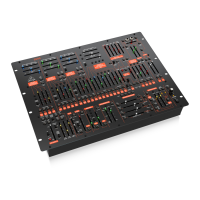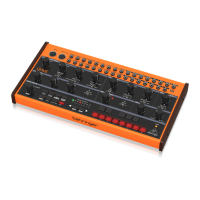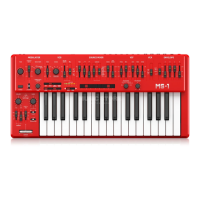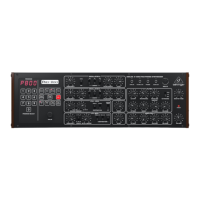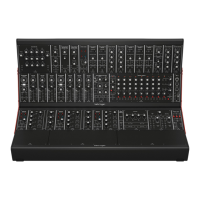Do you have a question about the Behringer DEEPMIND 12 and is the answer not in the manual?
| Product type | Analog synthesizer |
|---|---|
| Product color | Black |
| Keyboard number of keys | 49 |
Legal notice regarding reliance on manual content and specifications.
Details on warranty terms and conditions, and where to find more information.
Overview of the DeepMind 12 synthesizer and its purpose.
Detailed list of the synthesizer's capabilities and components.
Description of the primary controls located on the top panel of the synthesizer.
Explanation of the input and output jacks and ports on the rear panel.
How to access, navigate, and select programs from the synthesizer's memory.
Information on assigning and browsing programs by category.
How to save programs as favorites and manage the favorites list.
Procedures for loading default programs and reverting control positions to panel settings.
Explanation of the information displayed on the PROG page during performance.
Details on using the keyboard's velocity and aftertouch features for expression.
How to use the pitch bend and modulation wheels for expressive control.
Adjusting the keyboard's octave range and controlling note glide time.
Overview of the analog signal path from oscillators to outputs and effects routing.
Configuration and routing possibilities for modulation sources and MIDI signals.
Accessing and navigating the synthesizer's main programming menu.
Overview and selection of the onboard effects processors and their configurations.
Accessing and navigating global settings for connectivity, keyboard, panel, and system.
How to program chords, arpeggios, and control sequences for musical patterns.
Controlling Low Frequency Oscillators and Oscillator sound generation.
Managing voice allocation, filter, and amplifier settings for sound shaping.
Configuring envelopes, curve shapes, and the modulation matrix for dynamic sound control.
Comprehensive list and descriptions of all available effects and their parameters.
Quickly reset parameters or change poly chord banks using shortcut combinations.
Shortcuts for quickly changing LFO waveforms and oscillator modulation sources.
Shortcuts for selecting VCF LFO sources and configuring modulation matrix buses.
Shortcuts for adjusting polyphony and accessing program help information.
Diagram showing a typical studio setup for the DeepMind 12 synthesizer.
Diagram illustrating a typical live performance setup for the DeepMind 12.
Diagram for a common setup used during band rehearsals or practice sessions.
Example of connecting the DeepMind 12 with modular synthesizer systems.
Diagram showing connections with external sound modules and MIDI controllers.
Diagram illustrating how to connect multiple DeepMind units for poly chaining.
Details on display, menus, presets, USB, Wi-Fi standards, and power.
Information on voices, OSC, LFO, VCF, envelopes, modulation matrix, and digital effects.
Specifications for keyboard, encoders, faders, switches, and input/output connections.
Chart detailing MIDI messages transmitted and recognized by the synthesizer.
List of continuous controller messages and their corresponding parameters.
Detecting synth presence and retrieving global MIDI channel setting via SysEx.
Messages for control app connection, enabling SysEx/NRPN, and sending device info.
Explanation of the packed data format used for SysEx bulk dumps.
Step-by-step guide for updating the synthesizer's operating system firmware.
Solutions for common problems like no sound, unresponsive controls, or MIDI issues.
Visual guides for octave shifting and ARP/SEQ/LFO synchronization timing.
Explanation and examples of Poly Chord creation using the WIZARD.
Procedures for using default programs and reverting controls to panel positions.
